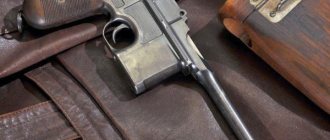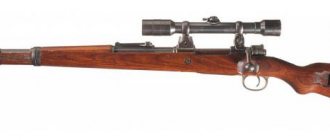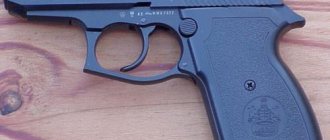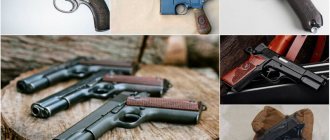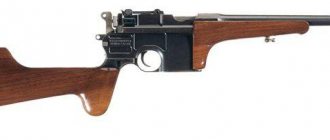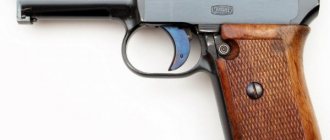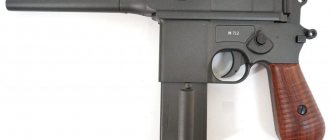The end of the 19th century was marked by a qualitative leap forward for the entire arms industry. This is largely due to dramatic improvements in the industrial sector. The emergence of new metalworking machines and other industrial equipment ensured the perfection of metalworking technologies. Both firearms designers and industrialists did not fail to take advantage of this. During this period, the most famous examples of handguns, revolvers and pistols, rifles, carbines and machine guns appeared. It was with these weapons that the armies entered the next 20th century, formidable and warlike.
We know the Nagan and Colt revolvers well, but they are followed by an equally famous weapon - the German Mauser pistol, which appeared at about the same time. If revolvers became popular due to their technical simplicity, high combat accuracy and elegant appearance, then Mauser became a household name. This model was characterized by fire power and a high sighting range. In terms of magazine capacity and rate of fire, the German pistol had no equal among other models. The weapon was striking in its size and weight, which aroused respect not only for the pistol itself, but also for its owner.
In a word, the army, the police, and other paramilitary structures have long needed a weapon that, in its tactical and technical characteristics, would be comparable to the action of a carbine or rifle. Even today, 100 years later, when you pick up an ordinary weight and size model of a Mauser pistol, you can’t help but feel awe of its power. There are not many weapons like the MMG Mauser, produced by gunsmiths for participants in military reconstructions and collectors. The pistol is unique and interesting for many reasons.
Mauser
Mauser in cinema
One of the first Soviet films featuring this Mauser model was “Man with a Gun” (1938). This film is also an exception - almost all subsequent Soviet films featured a modification of the Bolo, with a short barrel, which often did not chronologically correspond to the events on the screen. However, among the modern population, the Mauser K-96 gained popularity not because of this film, but thanks to famous Soviet post-war films about the revolution and civil war, such as: “White Sun of the Desert”, “Officers” and “The Elusive Avengers" as well as in modern film "The Nightingale the Robber". In foreign cinema - the western “The Great Silence” (1968). Science fiction film "The Fifth Element". Mauser also played the role of the DL44 blaster in “Star Wars.” In the film “The Plane Flies to Russia” this pistol can be seen in the possession of one of the Gazazat Gaytsy bandits. In the film Sherlock Holmes: A Game of Shadows, the Mauser was developed back in 1891 by Professor James Moriarty as a new weapon for the German Empire, along with the first machine guns and light machine guns.
Reflection in culture and art
In Russia, the Mauser became popular thanks to cinema and literature, as an integral part of the image of a White Guard, Makhnovist or communist during the Civil War, along with a leather jacket and a scarlet breast bow.
In literature
Pistols are mentioned in many literary and artistic works.
- Poem by Vladimir Mayakovsky “Left March” (“...Your word, Comrade Mauser!..”).
- The novel by Ilya Ilf and Evgeny Petrov “The Twelve Chairs” (a story by Ostap Bender about a hussar-schemnik) (“They were tall people in boots with spurs, in huge riding breeches and with Mausers in polished wooden boxes”).
- The Strugatsky brothers’ novel “The Doomed City” (“...then he opened the treasured closet and took out a hefty Mauser - a ten-shot monster, born in the special department of the Mauserwerk, the favorite weapon of commissars in dusty helmets, famous during the civil war, as well as Japanese imperial officers in greatcoats with dog collars fur. The Mauser was clean, blued, gleaming, seemingly completely ready for battle, but, unfortunately, had exhausted its service life....")
- Poem (song) by Bashlachev “Rusty Water” (“Red Firebird, saluting the barking Mauser…”)
- M. Weller's story "Papanin's Mauser"
Also, Mauser pistols are found in many films and computer games.
Mauser in computer games
- "" - model 712 for a German grenade launcher as an auxiliary weapon.
- “ Medal of Honor: Airborne
” – in this game the Mauser can be “upgraded” to the 712 model. - " Hitman: Blood Money
" - in the mission
Curtains Down
(Curtain Falls) at the cloakroom attendant. The actor on stage also has it (with singles). - " Resident Evil 4
" - Red 9 model, which is an exact copy of the Mauser C-96; in Russian localization it is called “Mauser”. - “ Fallout
”, “
Fallout 2
”, “
Fallout Tactics
” - Mauser S-96 in the 9x19 Parabellum version, shown with an enlarged magazine, but the magazine holds 7 rounds (the name in the game is Mauser M/96 HSI). - " Fallout 3
" - Chinese prototype of the Mauser S-96 in the 10 mm version, called the "Chinese Pistol". - “ TimeZero
” – used as a reward weapon, in the game it acts as a weapon at the initial levels. - " Mafia 2
" - Mauser is available at the very beginning of the game, later you can buy it in the store. - “ CrossFire
” – A very popular paid weapon, model 712.
Unloading "MAUSER" K-96
To unload the pistol you must: smoothly release the trigger if it has been cocked; turn the pistol with the handle up and, grasping it with the fingers of your left hand and holding the magazine cover with your thumb, recess the magazine latch and slide the cover forward; separate the magazine cover with the spring and feeder from the gun; turn the pistol with the magazine down and empty the cartridges; lower the safety down if the trigger was set to safety; pull the shutter back all the way; if there was a cartridge in the barrel, it will be ejected by the bolt using an ejector; release the bolt, which, under the action of the return spring, without encountering the feeder protrusion on its way, will take its original position; smoothly pull the trigger; insert the feed mechanism into the magazine and secure its cover using the latch protrusion; collect cartridges in a clip.
History of the company
Paul Mauser
Paul Mauser began working at a weapons factory at the age of 12. In 1868, he, along with his brother Wilhelm, who was a little older, and the American Charles Naris, received a patent for a single-shot rifle.
In 1871, the armies of Prussia and Württemberg armed themselves with this rifle, and in 1874 the government arms factory was transferred to the Mausers. He later became the famous weapons manufacturing company called “Brothers Mauser and Co.” It was headed by Wilhelm.
But in 1882 he died, and the company was transformed by his brother into Waffenfabrik Mauser AG.
In 1884, a new manager was appointed - Fidel Federle.
In 1893, the Federle brothers designed an automatic pistol. But, as often happens, the sample was not without all sorts of flaws.
Over the next two years, the three brothers-designers improved the design of the weapon. They were joined by Mauser and Gaiser.
As a result, on March 15, 1895, a modified version was presented, called the Mauser C-96, which later became one of the most legendary firearms.
On August 1, 1896, the capabilities of the new weapon model were demonstrated to members of the weapons commission in the city of Stuttgart.
Production of the sample began in 1897.
Pistol design
The Mauser was an automatic pistol. Its automation worked by using the recoil energy of the barrel, which had a short stroke. Many elements in the design were inherited from revolver models. But, thanks to its bold technical solutions, the Mauser is not a revolver.
The pistol holster deserves special attention, since it also doubles as a butt. The material for its manufacture was almost always wood, but occasionally you could find models made of plastic. The holster was attached to the pistol handle thanks to a special clamp, which was located on the “nose”. Using the holster as a butt, it was possible to hit manpower at distances of up to 100 meters.
The pistol magazine could have a capacity of 6 or 10 rounds. At the same time, it was integrated, and it was loaded using a clip with the barrel open.
Versions of the pistol with detachable magazines had a larger capacity. It was 20 or even 40 rounds. The original pistol was originally designed for 7.62X25 caliber. But, as mentioned above, due to the emergence of stronger competitors, various modifications were designed for 9X19 and 45 ACP cartridges.
An interesting fact is that at the peak of its popularity, the Mauser C-96 was considered a hunting pistol carbine, as it had a large weight (more than 1.25 kg) and a powerful cartridge.
Bottom line
The Mauser C-96 is undoubtedly a legendary weapon. It embodied bold design ideas, which have now been replaced by more modern analogues.
Design of His Majesty Mauser
The weapon has a revolver layout, in which the center of gravity is located in the center of the main body. Unlike conventional automatic pistols, in which the magazine was located in the grip, the Mauser has a magazine in the front of the weapon. The trigger is located between the handle and the magazine.
Mauser circuit
The automatic action in the pistol design is based on a short barrel stroke during recoil. This scheme was first tested by the Germans and brought to perfection. The large capacity magazine, 10 rounds on standard K96 models, and the long barrel – 140 mm – gave the pistol an undeniable advantage over revolvers and pistols of other systems of that time. However, despite the presence of undeniable advantages, the design had a significant drawback. Without a loaded magazine, the Mauser C96 weighed 1250 kg. Its size was also impressive. Holding such a heavy weapon in one hand to conduct aimed fire is clearly problematic. This shortcoming was compensated by the fact that the weapon was supposed to be used as a light carbine and was intended to be fired with two hands and using a butt.
Mauser in a holster
The German design school is visible in everything. The pistol had to use a powerful cartridge, either the native 7.63x25 Mauser cartridge, or the 9x25 Mauser cartridge, or the 9 mm Parabellum cartridge. The design, despite all its technological complexity, had amazing survivability, as participants in the battles of the Civil War in Russia and the fighting in China have repeatedly said. The C96 Mauser pistol was equipped with a wooden holster, which was worn over the shoulder as a sword belt and could be used as a butt. When firing from a pistol with a fastened holster, the aiming range increased and the effectiveness of fire increased. In a later modification of the Mauser 712 pistol, produced since 1932, it became possible to fire automatically in short bursts. The holster in this case was indispensable, as it helped to better secure the weapon during shooting.
The main tactical and technical data of the pistol were impressive and looked like this:
- weapon weight without magazine 1250 g;
- weapon length 312 mm;
- initial bullet speed 425 m/s;
- sighting range 200 m without stock;
- declared range 1000 m, actual range 500 m;
- ammunition capacity of 10 rounds in the traditional modification, 20 and 40 charging magazines of later versions for firing in automatic fire mode.
Mauser with magazine
Notes
- ↑, p. 31-50.
- ↑, p. 96.
- (English). Gunsworld.com.
- ↑ Semyon Fedoseev. That same Mauser // magazine “Master Gun”, No. 5-6, 1996. pp. 12-18
- (English). Gunsworld.com.
- ↑
- , p. 23.
- ↑, p. 111-113.
- Victor Klenkin. The legendary Mauser K.96 // “Weapons and Hunting” magazine, No. 1, January 2007
- ↑ K-96: the legend continues // “Master Gun” magazine, No. 12 (153), December 2009. pp. 32-39
- Small arms of Bulgaria and Turkey during the First World War // “Weapons” magazine, No. 13, 2014. pp. 1-3, 46-58
- A. Krylov. Weapons of the Red Commanders // “Technology for Youth”, No. 2, 1968.
- , With. 464.
- , With. 158: “The commanders of the Red Army were mainly armed with revolvers; many had a not very familiar TT. Some commanders and commissars, especially from the highest echelons, were armed with long-barreled Mausers in wooden stocks
, Korovin pistols, and Brownings.” - P. Alexandrov. Return // magazine “Smena”, No. 7-8, July 1941. pp. 14-15
- , With. 227.
- In raids with Kovpak // Ya. I. Makarenko. Lines from fire. M., Politizdat, 1985. pp.108-112
- (Ukrainian) (August 15, 2011).
- (English).
- , With. 18.
Mauser S-96 advantages and disadvantages
The first war in which the famous pistol took part was the 1st Anglo-Boer. The hero of this war, Ben Vilhen, became the author of the famous motto “With God and with Mauser!” Between the start of production and 1908, 70 thousand pistols were produced.
In 1900, the more competitive Parabellum and Browning pistol appeared. In comparison with them, all the flaws were clearly visible.
disadvantages of the Mauser C-96
- large overall dimensions
- inconvenient charging process
- high cost of production
- complex assembly and disassembly process
- sensitivity to dirt, which is unacceptable in military conditions.
As a result, even in Germany itself, the famous pistol was only partially adopted for equipping mounted rangers, and then due to insufficient equipment with Parabellums. At the same time, it was necessary to change the design of the Mauser to allow the use of parabellum cartridges with a caliber of 9X19 mm.
Mauser 9mm
These samples had the number “9” in red on the handle. The fact is that when firing 9 mm ammunition from this model, designed specifically for 7.63 mm caliber, the barrel was destroyed as a result of a rupture.
pocket Mauser model
In 1897, the first examples of Mausers appeared in Russia. At that time, they were on the list of models that were recommended for purchase by officers. A pocket model of the 6.35 mm Mauser appeared in 1910.
In Russia, the Mauser quickly gained popularity. In July 1928, a standard 7.62 mm caliber ammunition was created in the Soviet Union. It was obtained by equating with the “three-line” one. The primer for the cartridge was taken from a revolver.
Mauser 1912
The Mauser was modernized several times. One of the most popular designs was the 1912 model. Its distinguishing features were good ballistic data and incredible survivability.
Taking the Mauser C-96 model as a basis, a model of an automatic pistol called the Astra 900 was designed in Spain. Models 901-904 already had a firing mode translator.
Mauser models of various calibers were also produced in China. Thanks to the Model 712 “Schnellfeuer”, the “Hollywood style” of shooting appeared, in which the pistol is held in a horizontal plane. This style is quite practical when using a Mauser, since it is very difficult to conduct aimed fire in a vertical plane during high-speed fire attacks.
Possible tuning (upgrade)
Since the pistol does not belong to the class of powerful gas-cylinder pneumatics, the main direction of its upgrade is related to increasing the initial speed of the bullet. A significant result is achieved by strengthening the mainspring, which provides the speed and force of impact on the valve, as well as boring the pneumatic chamber.
Such an upgrade, carried out independently, can lead to failure of the device. This is facilitated by the high percentage of relatively fragile plastic parts in which all the components of the mechanism are secured. This upgrade is recommended to be carried out in workshops that specialize in servicing air guns.
The Mauser S96 pistol is one of the brightest examples of gas-cylinder pneumatics, intended for recreational shooting and satisfying the need for an outdoor weapon.
Compared to other models, the Legends C96 is a truly iconic pistol that captures all the drama of its predecessor's era. Review of the Mauser C96 air pistol:
Types: experimental, production models
In 1945, moving deeper into German territory, the Allied army captured Oberndorf, which housed a weapons factory (built at the beginning of the 19th century by order of the King of Württemberg) of the Mauser brothers (the brothers bought the company from the Württemberg government).
After the capture, a certain US Army officer ordered the destruction of all documentation of the plant. Therefore, today it is impossible to establish the exact number of variants of weapons produced. However, it is still possible to consider known types of pistols.
Pistol models can be divided into experimental ones, which were produced from 1895 to the 1900s, and those that went into mass production:
- K96 "ConeHammer". A distinctive feature is the presence of a round trigger. Also, the notch on the cheeks of the “Cone Hammer” handle could have a diamond shape. This model provided for the use of clips with a capacity of six to twenty rounds. The pistol's production lasted from 1896 to 1899.
- “Large Ring Hammer” – the trigger is now in the form of a large ring.
- "Flatside" A sample made specifically for the Italian Navy.
- “Small Ring Hammer” - a trigger in the form of a small ring. This modification is the main one. The trigger had the letters "NS" on it.
- “Large Ring Hammer Bolo” or “Bolshevik” - short barrel and handle compared to the original, large trigger in the form of a ring. Clip holds up to six rounds. "Bolo" is chambered for 7.63 mm. The bulk of the lots were sold to Russia from 1922 to 1925.
- Mauser 1910 is a new pocket version of the K96 with a caliber of 6.35 mm.
- The Mauser 1914 is a smaller model based on the 1910 pistol. Used as a weapon of limited standard. The 1914 Mauser Werke pistol was intended for the police and civilian markets. The Mauser 1914, along with the newer 1934 model, was used by the Wehrmacht and SS paramilitary forces.
- K96 1916 - Mauser chambered for 9 mm. A distinctive feature was the presence of the number nine on the handle.
- Mauser 712 “Schnellfeuer” with a fire mode selector and a magazine with a capacity of twenty rounds.
Spain developed its own version of the K96, produced by Astra. Later modifications of this model received a fire mode translator. In China, the K96 was widely used during the militaristic era. Mostly copies were created with the 7.63 mm cartridge. They were called Hanyang. In Brazil, the police created their own submachine gun based on the K96 - “PASAM”.
The capacity of magazines (clips), given the many types of pistols, differed from each other. Modifications were created for six, ten, twenty, and even forty rounds. The magazine was loaded from Mauser pistol clips with a capacity of ten rounds. At first, the Mauser caliber was 7.63 mm.
A number of companies produced weapons that imitated the Mauser pistol in appearance:
- LugerMk II;
- Erma KGP-68;
- "Baby parabellum" (according to the Treaty of Versailles).
Mauser is found in many literary and artistic works:
- “The Legend of Papanin’s Mauser”;
- "Rusty Water";
- "Doomed City"
- "The twelve Chairs";
- "Left March";
- "Maigret and the Ghost".
Today, pneumatic analogues are produced, an example of which is the sample. Assembled as the M-712 model, but with its difference from the original - it cannot fire automatically.
M-712 from - the shooter can fire automatically and disassemble the weapon. There is also AS Mauser - an analogue from SAS.
The German Mauser K96 pistol gained popularity due to its extraordinary design. Widely used in many wars (even in the Chak War of 1932-1935 between Paraguay and Bolivia), including World War II and World War II.
The K96 had both positive qualities and disadvantages, which did not in any way affect its widespread use. It was not in service in virtually any country in the world, but this did not diminish its popularity. The production of pistols continued until 1939.
History of creation
Despite its name, the pistol was not developed by Paul Mauser himself, but by the Feederle brothers: Fidel, Friedrich and Joseph. Fidel Federle was in charge of the experimental weapons workshop (Waffenfabrik Mauser), and the new pistol, which was initially called the P-7.63 or Federle pistol, was developed without the knowledge of P. Mauser. However, production began in 1896 and continued until 1939. During this time, more than a million C96 pistols were produced. The pistol was patented in the name of Paul Mauser in Germany in 1895 (German Reichspatent No. 90430 dated September 11, 1895), in Great Britain in 1896. After the Treaty of Versailles, when Germany was prohibited from producing weapons with a caliber of more than 7.96 mm, production The K-96 model was deployed by the Spanish, which owns most of the K-96 pistol models. The Mauser K-96 pistol, familiar to everyone from movies about the revolution - this is the so-called "Bolo" (Bolshevik) model chambered for the 7.63x25 mm Mauser - the latter was later even adopted by the Red Army in a slightly modified form as 7.62 ×25 mm TT.
One of the reasons why the Mauser pistol became popular among revolutionaries, White Guards and bandits during the Civil War was its enormous power, for those times. The pistol was positioned as a light carbine, which in essence it was: a wooden holster was used as a butt, and the destructive power of the bullet was claimed to be at a range of up to 1000 m (however, the horizontal spread of bullets for a stationary pistol was up to several meters, so precision shooting at such a range was out of the question).
The pistol's high cost made it a suitable gift for the young cavalryman Winston Churchill from his wealthy mother. Churchill used this pistol in cavalry charges during the Boer War.
The K-96 model is one of the record holders for the number of modifications, of which there were more than a hundred.
Locking mechanism "MAUSER" K-96
Before studying the operation of all the parts and mechanisms of the pistol, it is necessary to understand the principle of operation of the locking mechanism, since a similar locking system is used in the Walter P-38, Mauser K-96, Beretta-92 pistols and in the modern Walter model. R-5. To make things easier to understand, let’s look at a slightly simplified diagram of how the mechanism works.
Scheme of the locking mechanism:
AB - locking latch (A - axis; B - lower spout; D - protrusions);
B—protrusion of the frame liner.
The bolt that locks the barrel bore is connected to the receiver using the locking latch AB
, located in a vertical plane, which can rotate around an axis
A
passing through the receiver.
Engagement is carried out by two protrusions D
of the locking latch, which fit into the corresponding recesses of the bolt.
In this case, the lower pin B
of the locking latch rests on the bevel of the protrusion B of the gun frame liner.
When fired, the bolt moves back under the pressure of the powder gases. Since the bolt is engaged with the receiver by protrusions D
of the locking latch, the box moves with the bolt until finger
B
of the locking latch, sliding along the bevel of protrusion
B
, rests against the ledge of the gun frame liner.
The locking latch rotates around axis A
, the protrusions
D
come out of the recesses of the bolt, and it disengages from the receiver.
The barrel and receiver stop, the bolt moves further alone until the barrel bore is unlocked. When the bolt moves back under the action of the return spring, when it reaches the barrel and begins to move it forward along with the receiver, nose B
of the locking latch with its lower surface reaches protrusion
B
and begins to slide along its bevel, lifting the locking latch.
The protrusions D
of the locking latch fit into the recesses of the bolt, and the barrel bore is locked. Initial position The barrel with the receiver and the bolt are fixed in the forward position under the action of the return spring.
Longitudinal section of the MAUSER K-96 pistol
(A - trigger pulled; B - trigger cocked, bolt in rear position):
1 — frame base; 2 — cheek of the handle; 3 — feeder; 4 — magazine box spring; 5 — bottom of the store; 6 — bottom clamp; 7 — trigger; 8 — trigger spring; 10 — frame insert; 11 - latch; 12 - trigger; 13 — trigger axis; 14— mainspring; 15 — guide rod; 16 — emphasis; 17 — earring; 18 — trigger lever; 21 — trunk; 22 — sighting bar; 23 — sighting bar spring; 24 - clamp; 26 - shutter; 27 - drummer; 29 — return spring; 30 — return spring stop; 32 - locking latch.
The bolt with the cup rim is pressed to the breech end of the barrel. The return spring is at its lowest preload. The locking latch, placed by the neck in the socket of the receiver protrusion, can be rotated in this socket (in the description of the operation of the locking mechanism, the neck was replaced by axis A). The locking latch rests on the liner from below in such a way that its neck is covered in front by the surface of the profile bend, and the rear locking surface is turned upward. The locking teeth of the latch fit into the grooves of the bolt, and the finger rests on the protrusion of the liner. The bore is locked. The extension of the neck of the latch extends beyond the long shoulder of the earring and interacts with it, and the finger fits into the shaped transverse groove of the frame.
The long arm of the earring with its nose is engaged with the neck of the bolt latch, its middle part enters the groove of the mainspring stop and interacts with the rear part of the groove, and the ledge lies at the bottom of the groove of the liner, limiting the rotation of the earring. The trigger, under the action of the mainspring, is in the upper forward position. The mainspring is at its lowest compression. The feeder, under the action of its spring, is pressed to the bottom of the bolt. The trigger is in the forward position under the action of the rear branch of the trigger lever spring.
The trigger lever, under the action of the hammer axis spring, is pressed through the transmission lever with its sear to the cylindrical surface of the hammer cocking. The transmission lever, placed with its head and limiting protrusion in the socket of the trigger lever, is pressed with its finger against the ridge of the mainspring stop - the disconnector - and is located above the profile protrusion of the trigger. The fuse is on. Its semi-cylindrical protrusion enters with one half into the radial recesses of the figured groove of the trigger, stops it and moves it back somewhat, separating it from the firing pin due to the interaction of the cylindrical surface of the protrusion of the fuse axis with the wall of the radial groove of the trigger.
History of the development and development of the Mauser pistol
Weapons factory Waffenfabrik Mauser. It was here that the future symbol of the revolutionary movement, the Mauser c96, began its journey into history. Its developers were Friedrich, Fidel and Joseph Federle. The Mauzer 7.63 mm ammunition for the new pistol was created on the basis of the then most used cartridge with a bottle sleeve - Borchardt 7.65 mm.
Paul Mauser, director of the company, witnessed the final stage of development. He was not happy with the very fact of secret work, but as a businessman he immediately understood its prospects. In 1895, after joint improvements, the Mauser K-96 prototype fired its first shot. In the same year, the patent offices of Germany and Great Britain issued him a patent for weapons and design features.
August 1896. A pistol was presented to the German Minister of Defense and members of the weapons commission for trial. After approval, a year later the Mauser was put into production, which lasted until 1936.
In Russia it appeared as “Mauser No. 2” or “Mauser in the block”. Recommended for purchase for officers instead of a standard pistol. By order of the General Staff, it was an “airplane accessory”; officers of automobile and motorcycle units were armed with it. The pistol was never put into service, but gained popularity among the army.
Mausers came to the Basmachi of Central Asia thanks to the support of the White Guard movement from the West.
20s. To arm the fighters of the workers' and peasants' army, the emergency commission received a large batch of the "police model" - Mausers of 7.63 mm caliber.
In civilian life, the pistol was noticed by those who valued compactness, power, accuracy and firing range - travel enthusiasts, researchers, bandits.
Over more than forty years it has been modified several times. Work was carried out to reduce the hammer, replace the safety, and reduce the length of the barrel. Models were produced with a detachable box-type magazine and automatic fire was provided.
It was used in all military campaigns of the 19th-20th centuries: in the war of the Boer republics against the British Empire, the 1st World War, in the civil war in Russia, in Spain, in the 2nd World War. Many years later, they were confiscated from bandits in Afghanistan and Chechnya.
Pistol Mauser 1896 Mauser C-96 (Germany)
The Mauser C-96 pistol is an early version with a hammer with tapered sides.
Mauser C-96 pistol - early versions of integral magazines with 20 and 6 rounds.
The Mauser C-96 pistol is a variant with an attached holster-stock.
The Mauser C-96 pistol is a variant chambered for the 9mm Parabellum cartridge for the German Army (1st World War).
The Mauser C-96 “Bolo” pistol is a variant with a 99m barrel produced in the 1920s.
The Mauser C-96 model 712 pistol is a variant with a fire mode selector and a detachable magazine for 20 rounds.
The Mauser C-96 pistol is a drawing from a German manual from the early 20th century, explaining the operation of the automation (the bolt is closed and locked).
Mauser C-96 pistol - the same drawing, the bolt is open.
Characteristics
USM
: single action
Caliber
: 7.63x25mm Mauser (.30 Mauser);
also 9x19mm Luger/Parabellum and 9x25mm Mauser Empty weight:
1250 g
Length:
312 mm (with 140 mm barrel)
Barrel length:
140 mm (also 99 mm and others)
Magazine capacity:
10 rounds in integral box magazine (also 6 and 20 cartridges)
The development of a new pistol, later known as the Mauser C-96, was started by the Federle brothers, employees of the German company Mauser, around 1894. In 1895, the first samples appeared, and at the same time a patent was received in the name of Paul Mauser. The first samples appeared in 1896, and were presented to the German Army for testing, but were not accepted into service. However, Mauser C-96 pistols enjoyed considerable success in the civilian weapons market until the 1930s - they were popular among travelers, explorers, bandits - all those who needed a fairly compact and powerful weapon with a decent effective firing range - and In this regard, the Mauser C-96 still looks very good, and compared to many pistols and revolvers of the early twentieth century, it had a range superiority by several times. The pistol was repeatedly subjected to various modifications, the most significant of which were the transition to smaller triggers, new types of safety (changed several times), and changes in barrel length. In addition, in the early 1930s, the Germans produced models with detachable box magazines, including those with the ability to fire automatically.
The Mauser C-96 pistol participated in many wars, starting with the Boer War in South Africa (1899-1902), in the First and Second World Wars, in the civil wars in Russia and Spain (in the latter case, mainly copies of locally produced Mausers were used ). In addition, Mauser C-96s were purchased by China in the 1930s, and were even produced there under license, chambered in .45ACP (11.43mm).
The Mauser C-96 pistol is a self-loading pistol, built on an automatic basis with a short barrel stroke and locking with an under-barrel combat cylinder, swinging in a vertical plane when interacting with elements of the pistol frame. The larva is connected to a movable receiver, into which the barrel is inserted from the front, and a rectangular bolt moves inside it. With two teeth on the upper surface, the larva engages the bolt, and when the barrel-box-bolt group moves back, the larva lowers, releasing the bolt and stopping the barrel. When the bolt moves back, it throws up the spent cartridge case, cocks the open hammer and sends a new cartridge into the barrel. The magazines are box-shaped, located in front of the trigger guard; for most models they are permanent, with a capacity of 10 rounds. Options with magazines for 6 or 20 rounds were also produced (in small batches). All magazines are double-row, filled from above when the bolt is open, with one cartridge each or from a special 10-round clip (similar to the Mauser Gew98 rifle). If it was necessary to unload the pistol, each cartridge had to be removed from the magazine by manually working the entire reloading cycle with the bolt, which was a major design flaw. Later, with the advent of detachable magazines, this design flaw was eliminated. The safety lever was located in the rear part of the frame, to the left of the trigger, and in models of different years of production it could lock the trigger either in any position of the trigger (early models), or only after the trigger was manually pulled back slightly until it was disconnected from the sear (starting from 1912 year, the so-called “new type of fuse” was designated NS - “Neue Sicherung”). Sights are either fixed or with a range-adjustable rear sight, marked up to 1000 meters. Of course, this was nothing more than a marketing ploy - at a distance of 1000 meters, even in the best conditions, the spread of hits exceeded 3 meters. However, at ranges up to 150-200 meters, the Mauser C-96 provided quite acceptable shooting accuracy and lethality, especially when using a standard holster-butt.
Most Mausers were chambered for the 7.63mm Mauser cartridge (almost completely similar to the domestic 7.62x25mm TT cartridge). In addition, in 1915, the German army ordered Mausers chambered for its standard 9mm Parabellum cartridge. Such pistols were designated by a large number “9” carved into the cheeks of the handle and filled with red paint. In addition, a small number of Mauser C-96s were chambered for the 9x25mm Mauser Export cartridge.
From 1920 until the early 1930s, German Mauser C-96s were produced with shortened 99 mm barrels (in accordance with the restrictions of the Treaty of Versailles). It was precisely these Mausers that were purchased by Soviet Russia in the 1920s, and this fact gave rise to calling all short-barreled Mausers “Bolo” models (Bolo - from Bolshevik).
With Hitler coming to power in Germany, the production of army weapons began there with renewed vigor, and in the early 1930s the Germans developed new modifications of the Mauser C-96 - including the Mauser 711 and Mauser 712 models. Both models had detachable magazines with 10 or 20 ( sometimes even 40) rounds, and the 712 model also had a fire mode translator on the left side of the frame. The rate of fire of the 712 model reached 900 - 1000 rounds per minute, which, with a light barrel and a powerful cartridge, limited the use of automatic fire to short bursts, and required the use of an attached butt holster to ensure more or less acceptable accuracy.
In general, the Mauser C-96 is in some way a landmark, a classic example of self-loading pistols. It has both undoubted advantages (high range and shooting accuracy) and disadvantages (considerable weight and size, inconvenience of loading and unloading, an uncomfortable handle, for which in the USA it was nicknamed the “broomhandle Mauser”). Despite the fact that the Mauser C-96 was practically not in service as the main model, in the first third of the twentieth century it had well-deserved and widespread popularity.
Main modifications of the Mauser
Until 1905, all experiments with design changes were completed, and subsequent ones were associated with features or the search for new markets.
Maud. 1895 (“Mauser C96 Cone Hammer”). The trigger is rounded, the side protrusions are canonically shaped. In early versions there is a sharp transition between the receiver and the barrel, a handle with a diamond-shaped notch, and a safety button without a hole. Later, a pair of oval grooves appeared on the sides of the receiver to make the structure lighter; a non-through hole was drilled in the safety button, and the transition was smoothed out. Over three years, 16 thousand were produced.
Maud. 1905 - 1912 (1914) Pre-war commercial model. Barrel length is 140 mm, ammunition capacity is ten rounds of 7.63 mm. Sector, graduated sight, hole in the safety button, trigger head - a small ring, walnut lining. The export model with 9 mm Mauser Export was not a commercial success, replaced by 9 mm Luger.
Maud. 1912 (1914) - 1918 Military commercial model. Differences: new fuse design, there is no hole in the fuse, “NS” is marked on the trigger. Barrel with 6 grooves.
Conversion 1920 (police weapon). After Germany banned the production of weapons with a length of more than 100 mm, with a caliber of more than 8 mm, the barrels were shortened, remade for the 7.63 mm cartridge, sector sights were removed, and the handle was shortened. A contract for the French gendarmerie for 1 thousand products, a large contract for Russia (“Bolo”) for 5 and 15 thousand.
Maud. 1930 (Mauser C96 Postwar Bolo). The pistol is similar to the 1912-1918 model, but there are features: the front sight is located at the muzzle, a short handle, cheeks with 22 grooves.
Maud. 1931 (Mauser C96 M1932 / M712 Schnellfeuer). Used as a submachine gun, magazine capacity 10, 20 rounds, automatic fire at a rate of 800 rounds. / minute.
Abroad. In Spain they produce the Mauser c96 with the name “Astra”. During the era of the “militarists”, the Chinese produced spare parts and replicas (not always good ones).
Specifications
Technical characteristics of the Mauser c96 air pistol:
| Characteristics | Indicators |
| Caliber, mm | 4,5 |
| Bullet speed, m/s | 115-120 |
| Bullet type | metal balls |
| Magazine (drum) capacity, pcs. | 19 (in some variations 18 or 20) |
| Weight, kg | 0,795 |
| Length, mm | 290 |
| Energy source | carbon dioxide canister |
| Bullet type | steel or copper-plated balls |
| Material | body – plastic, mechanism and barrel liner – lightweight metal alloys |
| Power, J | 1-1,5 |
| Trigger type (trigger) | single action |
| Barrel length, mm | 140 |
| Barrel type | smooth |
| Fuse type | non-automatic |
| Sights | built-in, adjustable |
| , Germany |
Butt holster
The Mauser's design made it possible to conduct effective fire from a distance unprecedented for pistols - about 200 m, however, for effective aiming at such a significant distance, the shooter, in addition to the variable sight, needed a butt not provided for by the pistol design. The Mauser's butt was used in its holster, made of walnut wood, on the front section of which there was a steel insert with a protrusion and a locking mechanism for connecting the butt to the handle of the pistol, while the hinged cover of the holster rested against the shooter's shoulder.
The length of the holster-butt is 35.5 cm, the width in the front part is 4.5 cm, the width in the rear part is 10.5 cm. The holster could be lined with leather on the outside and have pockets for placing a spare clip and tools for disassembling and cleaning weapons, and was worn on a belt (narrow leather belt) over the shoulder.
The holster-stock also turned out to be indispensable for targeted burst shooting from a modification of the pistol developed in 1931 (the so-called “model 712” or “Mauser” model of 1932), on which a fire mode translator was additionally installed to select the type of shooting: single shots or in bursts.
Mauser M712 pistol
The Mauser M712 is an automatic pistol that had attachable 20- and 10-round magazines. It began to be produced in 1932. The gun was equipped with a Nikla trigger mechanism. The rate of fire ensured a rate of fire of 850 rounds/min. This model with a 20-round magazine and also an attached holster-butt was used as a small-sized submachine gun. Production of the M712 continued until April 1938. During this period, approximately 95,000 M712s were produced. Approximately 10,000 of these pistols were purchased for the SS troops. This weapon was also used by reconnaissance and sabotage units of the Wehrmacht.
The most famous copies
Shanxi type 17 (.45 ACP)
Used in China at the beginning of the 20th century, during the so-called militaristic era, specifically in the province of Shanxi, which was at that time under the control of General Yan Xishan. Yan Xishan built a modern military factory in the main city of Taiyuan province, which produced a copy of the 45-caliber Thompson submachine gun for his troops. This caused some problems, since the main weapon of his soldiers was the Mauser K-96, 7.63 mm caliber.
Thus, Yan Xishan authorized the redesign of the K-96 chambered for the .45 ACP cartridge, which should have simplified the supply of ammunition to the units. Designated as Type 17
, the pistol began to be produced by the Taiyuan Arsenal in 1929. The markings consisted of the Chinese inscriptions "Type 17" on the left side, and "Eighteenth Year of the Republic, Made in Shanxi" on the right. The weapon (along with the Thompsons) entered service with the railway guards, who protected the roads from bandits and detachments of other militarists.
Converted to chamber a larger cartridge, the Type 17 was noticeably larger than its 7.63mm counterparts, with a 10-round magazine that dropped below the trigger guard. To load the magazine, two clips of five rounds were used, instead of one clip of ten rounds like the original Mausers.
Most Type 17s were scrapped after the Communist victory, some, despite the non-standard caliber, were used by the PLA, and some found their way into commercial markets in other countries. About 8,500 Type 17 units were produced for Yan Xishan's troops, many of the examples available to collectors are late replicas.
Type 80 (7.62 mm)
Automatic pistol for PLA officers. The design is copied from the German M712 Schnellfeuer, but the grip is the same as the Type 64 pistol. Cartridge 7.62×25 mm TT.
Description of design
No significant changes were made to the mechanism and principle of operation. They have the same operating scheme - automatic with a blowback shutter.
The barrel, which is motionless during shooting, can be easily removed during disassembly. It is attached to the frame using a valley rod, inserted from the front under the barrel, and also passing through the hole in the stops on the lower surface of the barrel.
The trigger mechanism (trigger) is mounted as a separate unit. It is a hammer type, open hammer, single action.
A manual safety is used, which is located on the left in the cutout of the cheeks of the handle.
The pistol's magazine is double-row, rigidly fixed in front of the trigger guard. In subsequent versions, it represents an independent device, attached to the frame using a latch.
Most models use the “7.63 mm Mauzer” charge, similar to the 7.62x25 for TT.


